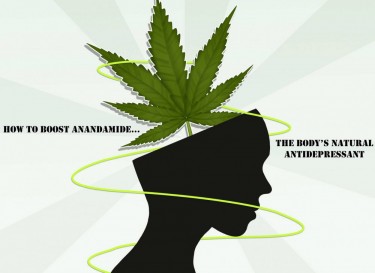
Anandamide, popularly known as the cannabis bliss molecule, aka AEA (for scientists), holds the mystery of the joy cannabis gives its users.
Cannabinoids are an exciting group of compounds. Over the years, cannabis-inclined researchers or scientists have made several discoveries concerning cannabis plants, their cannabinoid and terpene profiles, as well as their unique relationship with the human endocannabinoid system (ECS). It might interest you that the human body produces a natural class of cannabinoids, one of which is the anandamides.
As you read on, you'll get introduced to the world of anandamides, how they interact with significant cannabinoids like THC and CBD, and why they are referred to as bliss molecules.
General Overview of Anandamide
Anandamide is a primary endogenous cannabinoid produced in the human body. This class of cannabinoids is not as famous as their plant-derived counterparts, yet they react significantly well with one another.
The name "anandamide" literally means "the bliss molecule." So many people assume that this compound is informally called the "bliss compound," whereas it's just the literal meaning of the name. Anand means bliss or delight, while amide is used to describe the molecule's chemical formula.
Anandamide has unique traits and activities that help the ECS have a beneficial relationship with plant-derived cannabis plants. It wasn't discovered until the early 1900s, around the exact time THC, CBD, and other phytocannabinoids were discovered. Subsequently, science journals suggested that phytocannabinoids could bind to natural receptors in the human body to showcase their impacts. Between 1990 and 1995, Dr. Rapheal Mecholam and his research team reported successfully isolating anandamide from the human brain.
As mentioned earlier, anandamide is naturally produced in the human body in low quantities. The production process is distributed through different molecular pathways using multiple enzymes. Anandamide has a relatively short half-life that starts with N-arachidonoyl phosphatidylethanolamine (NAPE), the membrane precursor. When anandamide is released into the body, it dissipates quickly.
The Importance and Function of Anandamide
The endocannabinoid system (ECS) primarily comprises the CB1 and CB2 receptors. Both receptors interact with other factors to ensure the body's homeostatic state is maintained.
The research team consisting of Lumir Hanus, William Devane, and Mechoulam observed that the bliss molecule behaves like THC. Both compounds have a highly bindable reaction with cannabinoid receptors. Anandamide and THC are partial agonists of CB1 and CB2. They are capable of inducing effects on the CNS and the immune system. However, THC has a stronger, more innate relationship with the CB1 receptor. For a more extended period, THC catalyzes multiple chemical effects. In contrast, anandamide is fragile, which is another reason it cannot induce a significant psychoactive effect. It is instead responsible for inducing feelings of pleasure, rewards, inspiration, or motivation. Its location in the brain is mainly in areas that are relevant to memory, feeding, learning, and movement. Scientists say that anandamide allows humans to make or break neutral connections that foster memory and learning.
The primary function of anandamide is homeostasis. The brain regularly releases it to keep the endocannabinoid system in proper condition.
Cannabis and anandamide
Cannabis and anandamide have a unique, multifaceted relationship. Each cannabinoid in the cannabis plant has a different effect on the bliss molecule. Scientists would have preferred more information on the results of THC and CBD on the AEA molecule.
THC and AEA
THC and anandamide have similar profiles. They are both partial agonists of the CB1 receptor, and they have relatable chemical structures.
When the body breaks down THC, it proceeds to hijack the CB1 receptors, causing a more profound dramatic response, which manifests as psychoactivity. THC gradually influences the performance of the orbitofrontal cortex, hippocampus, basal ganglia, and cerebellum. The user can sometimes experience a lack of coordination and short-term memory.
THC and AEA stimulate the release of dopamine, which causes the user to feel pleasure. Dopamine is also involved in other actions like sex, feeding, and rewards.
The brain chemical dopamine is released when neurons transmit electrical signals to each other. The nature of the signal sent determines what choices you make in your day-to-day activities. Without dopamine, you would be unable to consciously or subconsciously get motivated, learn, switch moods, or retain a healthy attention span.
Note that the short-term irregular use of THC directly influences the brain's reward system—for as long as the compound remains active. Periodical use of THC could relatively lower the amount of dopamine produced, causing reduced motivation and other negative emotions. The anandamide molecules are directly influenced by
CBD and AEA
CBD the second prominent plant-derived cannabinoid. It reacts with the FAAH enzyme (the chemical involved in the breakdown of AEA).
CBD is the main reason why anandamide has a short half-life because it counteracts the effect of the brain chemical—as it holds off the breakdown of the FAAH enzyme.
Extending the availability of AEA in the body
Increasing the amount of anandamide in the body is not only achievable by smoking or using THC-based products. There are various other ways you can augment the bliss molecule, either by consuming certain foods, performing some activities, or using other minor cannabinoid products.
The main thing is to consume substances that inhibit FAAH or contain substantial amounts of anandamide. This way, the body automatically has an elevated AEA level.
Some of the substances you can consume include CBD extract, CBD oil, black truffle, chocolate, black or long pepper, and kaempferol. Exercises and activities like cuddling or yoga, biking, and long-distance running help increase anandamide levels. It is advisable to stick to endurance activities.
Bottom Line
In the long run, responsible cannabis use would help nurture a more open perspective on life. Scientific knowledge of anandamide and its relationship with cannabinoids has come a long way since the first cannabinoid was discovered.
There's still a myriad of information to uncover about how cannabis plants and cannabinoids could be maximized to help users feel happier in the long term. Until then, I recommend you continue using THC-based products in moderation. Always remember that with more cannabinoids, endurance-based exercises or activities, and a well-balanced meal, you stand to gain more bliss or pleasure as your AEA levels get boosted.
MORE ON ANANDAMIDE, READ THESE...
HOW DOES ANANDAMIDE WORK TO HELP YOU RELAX AND CHILL?





![When Cannabis Isn't Working for [Fill in the Blank] - Response to a Reddit Post](https://cannabis.net/drive/1000/3743_16ys_marijuanaisnotworking.jpg?width=350)

